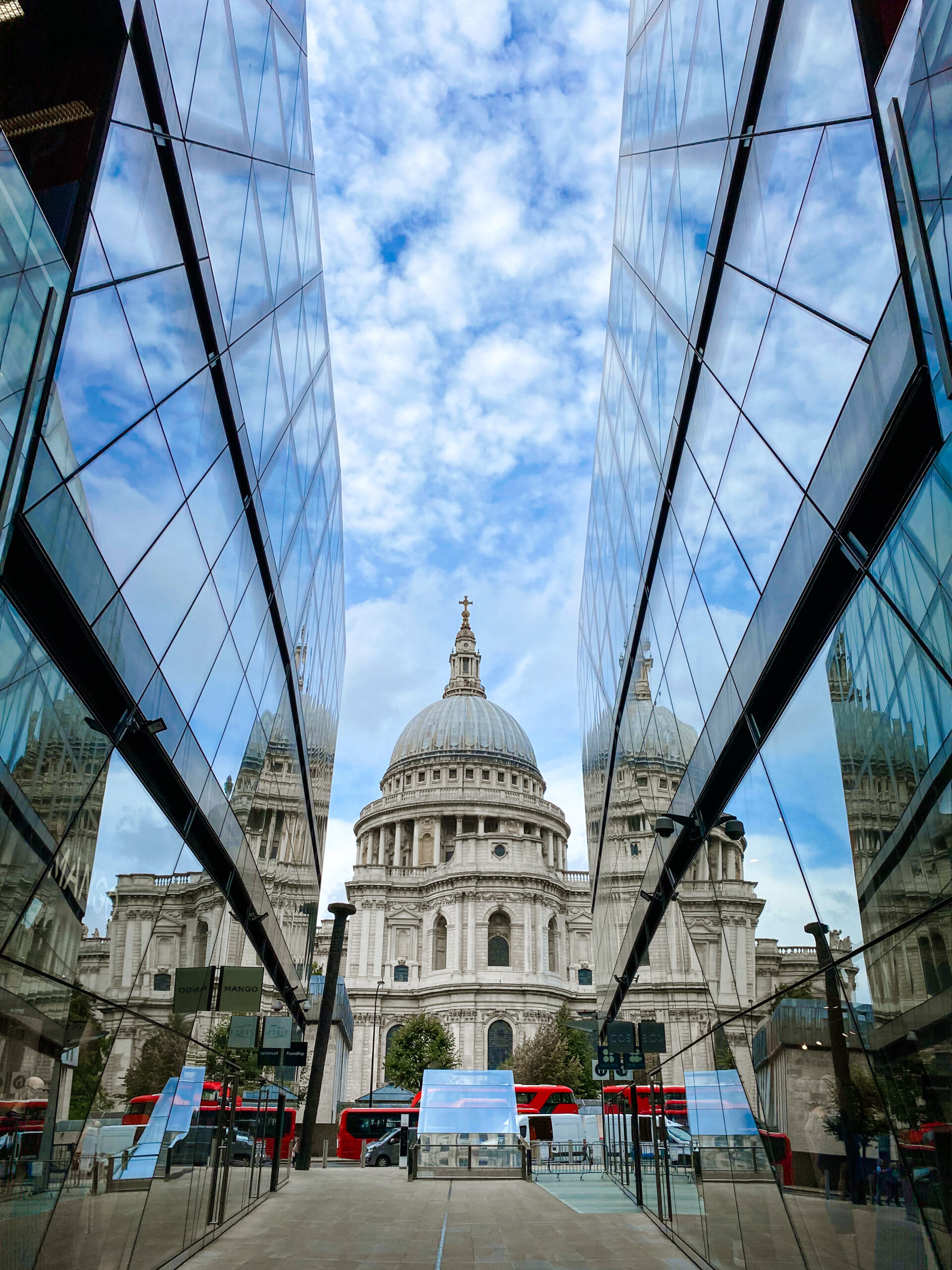
dessert
Your Complete Guide to Where to Stay in London for First Time Visitors
October 26, 2025
Trying to figure out where to stay in London for your first visit to the Queen’s city? It can be a bit daunting am I right??? I’ve been there. Scrolling through endless TikToks and random lists of neighborhoods, trying to decode whether “central London” actually means central. (Spoiler: sometimes it doesn’t.)
So to save you the headache, I teamed up with my friend Ben Bromley, a true London local to help you narrow it down. In this guide, we’re breaking down the best places to stay in London for first-time visitors, from classic landmarks in central London to the coolest areas in London you won’t want to miss. Whether you’re searching for where to stay in London first time or just want the inside scoop on the prettiest corners of the city, our list has you covered.
All the content below was written by Ben, but every design-forward boutique hotel was handpicked by me — so you’re getting the best of both worlds: a true London expert guiding you on where to stay in London for your first visit, plus my travel blogger eye for stylish (yet clean and comfortable) stays.
So take that last sip of your afternoon high tea and let’s get into it 👇
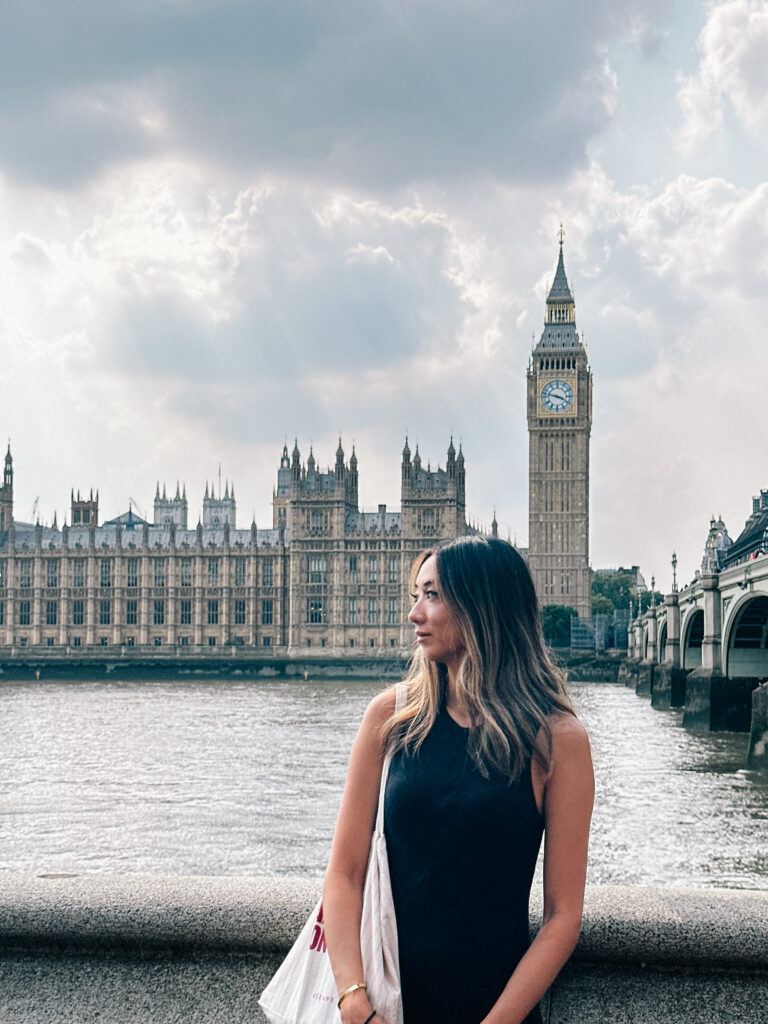
Read more on London 🇬🇧
This site contains affiliate links, which means I may earn a small commission if you make a purchase through them (which will likely go towards overpriced airport wine or buying my dog more unnecessary toys). However, none of that impacts the integrity of my reviews. All thoughts and opinions are my own.
Best Hotels in London at a Glance
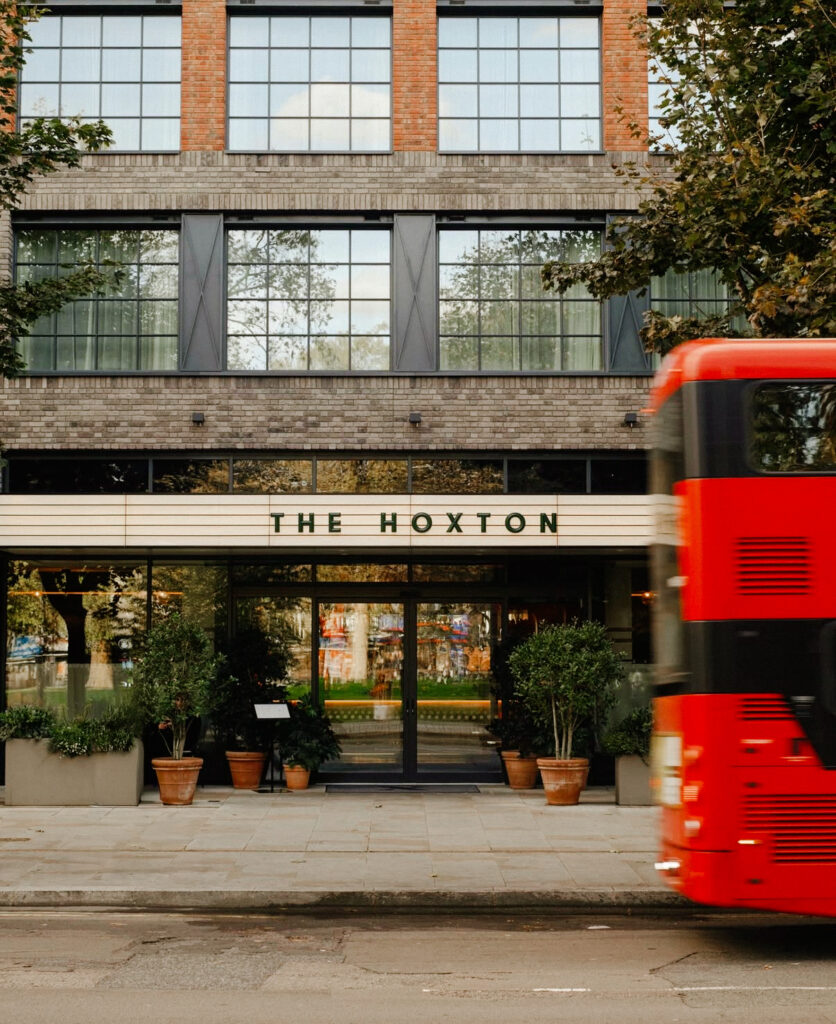
Short on time? Here are my top picks for the best boutique hotels in London for first-time visitors:
- The Hoxton, Holborn (Holborn) – Stylish and effortlessly hip, The Hoxton pairs industrial-chic interiors with a lively social energy — a top pick when deciding where to stay in London near Covent Garden and the British Museum.
- citizenM London Shoreditch (Shoreditch) – Modern, playful, and ultra-smart, citizenM blends sleek design with self-check-in ease — a top pick for where to stay in London if you love creative, personality-filled hotels.
- Hand & Flower (Hammersmith) – A cozy pub-with-rooms that balances old-world charm with updated comfort. Ideal for visitors craving the warmth of a classic London pub vibe and quick access to West London highlights.
- The Dixon, Autograph Collection (Southwark) – Housed in a restored Edwardian courthouse, The Dixon blends heritage architecture with modern luxury — a standout pick for where to stay in London if you love design and history.
- The Ampersand Hotel (South Kensington) – A boutique gem inspired by London’s rich cultural scene, featuring bold interiors and plush, artful rooms. Set just steps from the Natural History Museum and Kensington Gardens, it’s perfect for style-savvy explorers.
Figuring out Where to Stay in London: Overview
Ok so it might not boast the best weather, a pint costs nearly £8 and the people can be a bit rude (I’m saying this as a local), but London (and yes, I’m biased) is one of the greatest cities in the world. You’re never going to run out of things to do, the transport connections are excellent and the city has some of the best culture, history, shopping and dining of anywhere.
Whether you want to ride to the top of the Shard or step back into history at the Tower of London. Whether you want to channel your inner royalty at Buckingham Palace or ride the London Eye.
And whether you want to walk for miles along the unbroken Thames Path or hit up the old school East End, it’s all possible in London.
But by far my favorite thing about living in London is the sheer diversity of boroughs and neighborhoods. How you can go from the multi-million pound mansions of Kensington to the terraces of East London, massive green spaces like Hyde Park to beautiful river walks in Richmond and densely packed urban areas like Camden, with all the buzz it brings.
And diverse communities of all nationalities, creeds and religions mingling with tourists, whether at the Notting Hill Carnival or Soho’s London Pride.
London is a truly welcoming city, and if you’re planning a visit then I’ve got some great recommendations for where you can stay.
Snapshot of London Boroughs & Neighborhoods
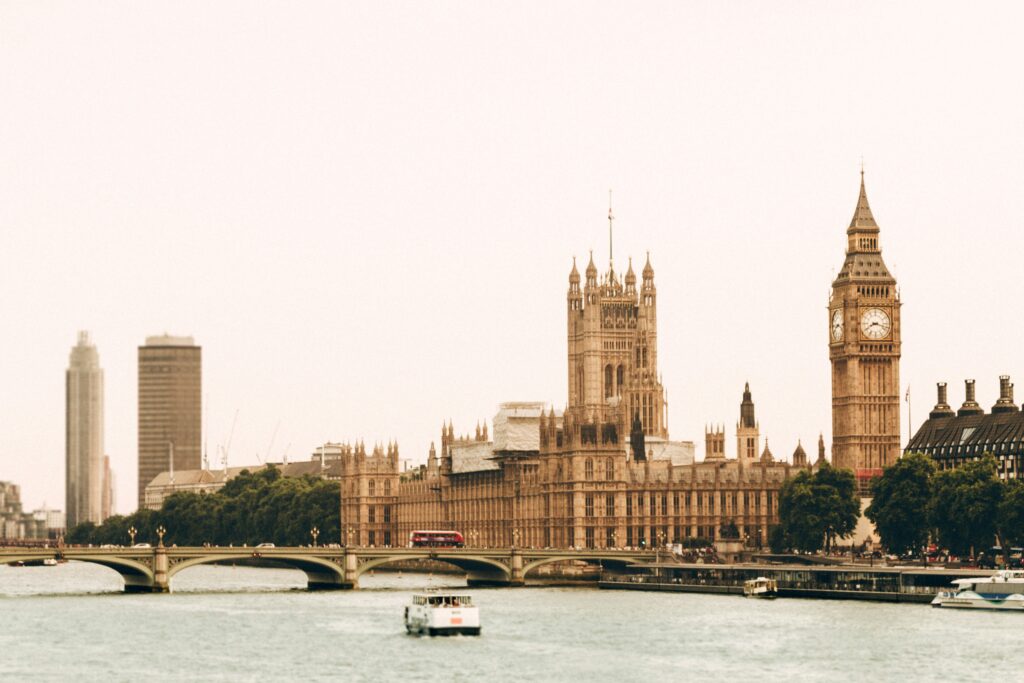
There are 32 London boroughs plus the City of London and most of these can be broken down further. You have better things to be doing than reading my thoughts on all 32, so I’ve taken five of my favorites to drill into: Covent Garden, Shoreditch, Hammersmith & Fulham, South Bank & Waterloo and Kensington. But before I get into those, there’s loads of other options for you to consider. Here’s a (very) brief summary:
Soho: Compact, lively, and packed with nightlife. London’s LGBTQ+ heart and perfect if you thrive on late evenings, cocktail bars, and tiny streets full of energy. The downside: it should be pedestrianized.
Mayfair: The most expensive property on the Monopoly board. Refined and exclusive, home to luxury hotels, Michelin-star dining, and high-end shopping. Not for you if you’re on a budget, but if you enjoy the finer things, it’s the neighborhood for you.
Notting Hill: I’m not even joking, I actually saw Hugh Grant drive his Lamborghini through Notting Hill once. Famous for its colorful houses and Portobello Road Market, plus the annual Notting Hill Carnival. Great for those who like bookshops, weekend markets, and a charming, village-like atmosphere.
Camden: Alternative, music-driven, and a little gritty. Best for younger travellers or anyone into live music, street food, and countercultural energy. You will pay £8 for a craft beer and it probably won’t taste very nice.
Greenwich: Massive redevelopment going on here, it’s still emerging but the appeal is there. A good option for families or history lovers wanting to check out the Cutty Sark.
Chelsea: Another of West London’s rich districts. Stylish and residential, with more Ferraris than Fiats. But also football-mad (I’m not calling it soccer, this is a guest post) and full of great pubs.
Richmond: Perfect for river walks and home to one of London’s largest royal parks, with deer sightings guaranteed. Ideal if you want calm, long walks, and a brush with well-heeled locals – celebrities from Mick Jagger to David Attenborough and Tom Hardy to Keira Knightley call Richmond home.
Bloomsbury: A quiet, walkable central base, with easy access to the British Museum and garden squares. Not too much going on after dark but well connected to the rest of the city.
Canary Wharf: London’s modern financial centre with towering skyscrapers and (uber expensive) riverside apartments. One of the top areas in London for business travelers or those who prefer modern hotels and easy Docklands connections.
Southwark: A perfect central location south of London Bridge, known for Borough Market, Southwark Cathedral, and The Shard. Ideal for foodies and anyone wanting a lively yet less tourist-heavy area close to central attractions.
Where to Stay in London: Covent Garden
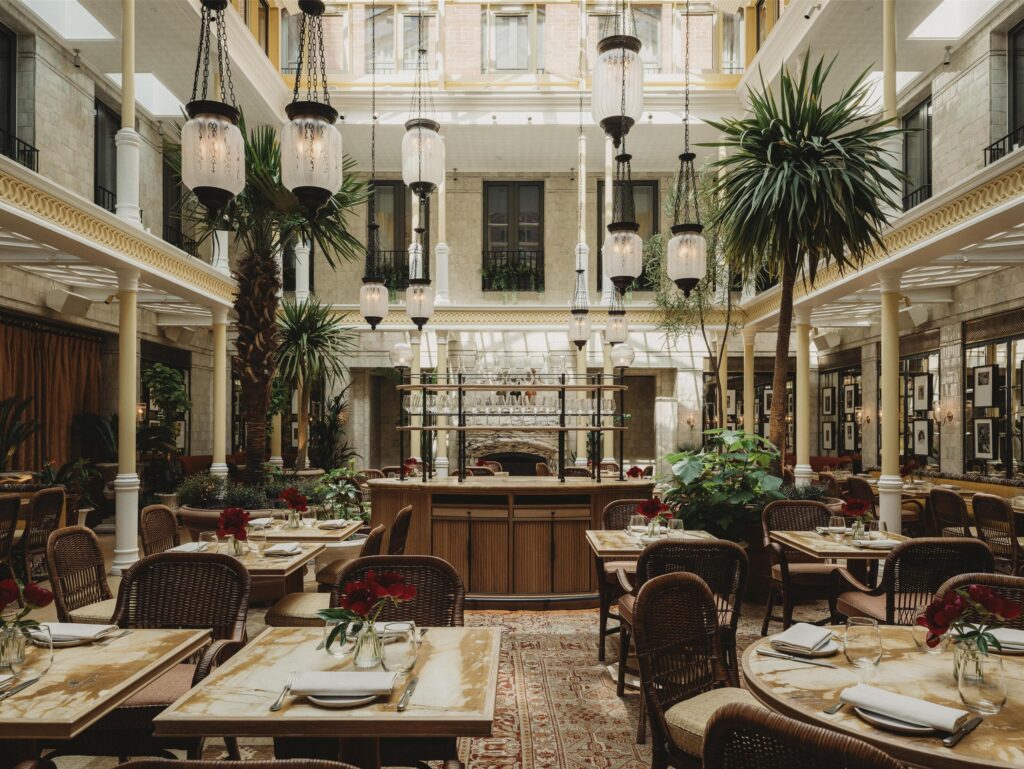
If money is no object and you’re trying to decide where to stay in central London, then Covent Garden is about as good as it gets.
The name comes from the fact that it used to be the garden of nearby Westminster Abbey and today it’s walkable, buzzes with activity at night and is close to many of the city’s top tourist attractions, including the West End, Trafalgar Square and cultural highlights including the National Gallery.
Transport links are excellent, in fact you’ll find it’s often easier to walk to Covent Garden from either Leicester Square or Holborn, as the Covent Garden tube station can be absolutely packed on a weekend evening – top local tip for you there.
There’s load of al fresco dining and drinking and you tend to find a street performer or two in the area. Just be wary, as pickpockets and phone thieves target the busy crowds, so take precautions when exploring.
And the biggest downside of Covent Garden is the cost of everything, especially accommodation and drinks.
Best Boutique Hotel Recommendations in and near Covent Garden
- The Z Hotel Piccadilly (West End) – A compact yet stylish budget-friendly option right in the middle of the action. With smart rooms, modern design, and a prime location between Soho and Leicester Square, it’s perfect for travelers who want to stay central without splurging.
- Club Quarters Hotel, Covent Garden Holborn (Covent Garden) – A practical and comfortable stay in one of London’s liveliest areas, this hotel is ideal for business and leisure travelers alike. If you’re deciding where to stay in London for easy access to West End theaters, restaurants, and attractions, this spot checks every box.
- The Hoxton, Holborn (Holborn) – Trendy and effortlessly cool, The Hoxton blends industrial-chic interiors with a buzzy social vibe. Perfect for design lovers who want a stylish base near Covent Garden and the British Museum.
- Page8, Page Hotels (Trafalgar Square) – A sleek boutique hotel offering a modern, minimalist retreat just steps from Trafalgar Square. With its bright rooms, calm aesthetic, and rooftop café, it’s a great pick for where to stay in London if you want a stylish base in the heart of the city.
- NoMad London (Covent Garden) – Set in a restored courthouse, NoMad brings New York sophistication to London. Expect luxurious interiors, a stunning glass-ceilinged restaurant, and the perfect mix of historic charm and modern elegance.
- One Aldwych (Covent Garden) – Contemporary and refined, this five-star hotel pairs elegant rooms with thoughtful touches like an indoor pool and an afternoon tea inspired by Charlie and the Chocolate Factory. A standout option for where to stay in London if you’re after quiet luxury in the West End.
- The Londoner (Leicester Square) – A five-star urban resort that’s both glamorous and intimate, offering sleek rooms, multiple bars and restaurants, and a serene underground spa. Perfect for travelers deciding where to stay in London for the ultimate luxury experience with everything at their doorstep.
Top Things to do in Covent Garden
Aside from eating, drinking and shopping, you can catch a show at one of the numerous West End theatres, jump into the history of the London Underground at the Transport Museum or take a short stroll along the river to Somerset House, home to a rotating array of art exhibitions throughout the year.
Looking for more things to do? My 2-day London itinerary is packed with can’t-miss attractions and foodie finds.
Where to Stay in London: Shoreditch
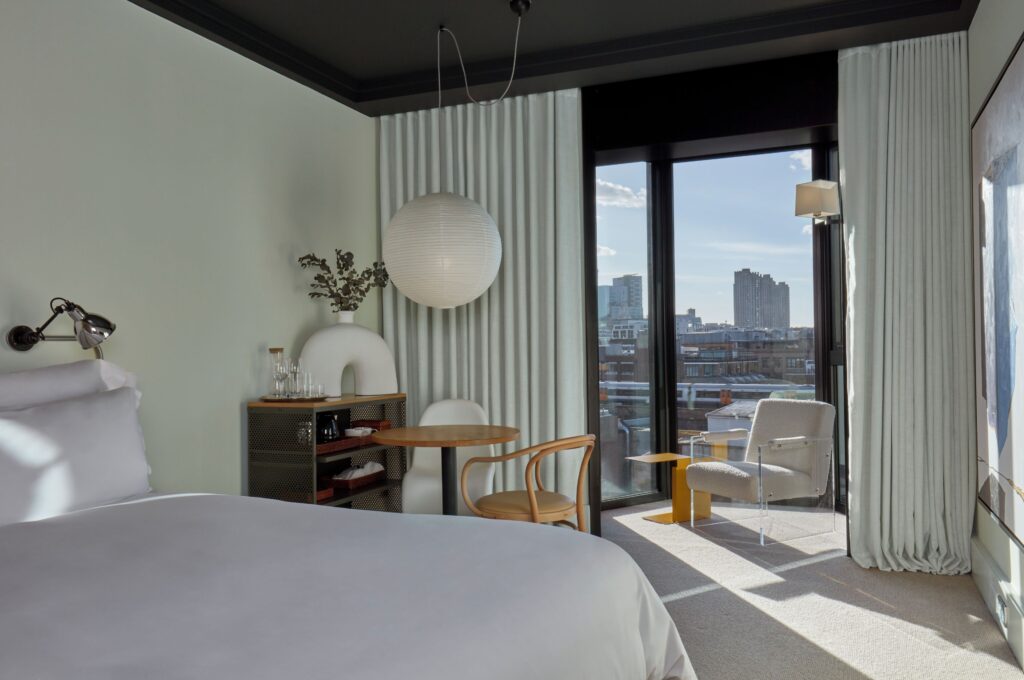
Shoreditch is an area to the east of central London, north of the City of London financial district. It’s a bit more edgy and creative, with fewer obvious tourist attractions but loads of options for nights out and dining – it’s a really popular place to live for people moving to London from elsewhere in the UK or arriving to work from Australia, the US and elsewhere.
Transport links to the city center are good, though it’s a bit more of a pain to get west (to Heathrow, for example).
In many ways, Shoreditch represents “new” London, and is a great example of an area that has evolved with the times – think industrial buildings converted into event spaces and nightclubs (Village Underground is one of my favorite nights out in London), bougee restaurants and lots of indie coffee spots.
The Tower of London and St Paul’s are two landmarks within easy reach and your accommodation costs will be lower here than in the centre, but by no means cheap.
If you’re a young person moving to London either for the short or long term then Shoreditch is one of the best places to stay in London, if you’re heading on vacation then it can work too, but you might prefer somewhere with better transport links.
Best Boutique Hotel Recommendations in and near Shoreditch
- Point A Hotel London Shoreditch (Shoreditch) – A simple yet stylish budget hotel with compact rooms and modern touches, ideal for travelers who value location and comfort without breaking the bank. Perfect for exploring East London’s creative scene on foot.
- The Z Hotel Shoreditch (Shoreditch) – A smart, budget-friendly stay offering contemporary design and excellent value. With compact rooms and a location right by Old Street Station, it’s great for first-time visitors who want convenience and affordability in one.
- citizenM London Shoreditch (Shoreditch) – Playful, modern, and tech-savvy, citizenM blends smart design with self-check-in convenience and colorful communal spaces. Perfect for solo travelers or couples who love a stylish stay with personality.
- The Hoxton, Shoreditch (Shoreditch) – Trendy and effortlessly cool, The Hoxton captures the neighborhood’s creative spirit with vintage-inspired interiors and a lively lobby scene. A great pick for design lovers and social travelers.
- One Hundred Shoreditch (Shoreditch) – A sleek, contemporary hotel offering airy rooms, warm tones, and one of the best rooftop bars in East London. Ideal for travelers who want a polished, modern base in the heart of Shoreditch.
- Virgin Hotels London Shoreditch (Shoreditch) – Vibrant and full of personality, Virgin Hotels brings a playful energy to Shoreditch with chic rooms, bold design, and a buzzing social atmosphere. Great for those who like a stylish stay with a side of fun.
- art’otel London Hoxton (Hoxton) – A design-led hotel that doubles as an art gallery, featuring works by contemporary artists and sleek, minimalist rooms. Perfect for travelers who appreciate creativity, culture, and a luxury boutique vibe.
- Pan Pacific London (Liverpool Street) – Refined and serene, Pan Pacific blends modern luxury with Asian-inspired hospitality. With spacious rooms, an elegant spa, and a pool overlooking the skyline, it’s one of Shoreditch’s most sophisticated stays.
Top Things to do in Shoreditch
A bring your own booze curry on Brick Lane is a London staple, and you can also browse for everything from antiques to street food at the Old Spitalfields Market. If electronic music is your thing then Village Underground is a great night out – bring your ear protection because the sound system is something else.
Can’t get enough of London? My 2-day London itinerary has everything you need — from top attractions to hidden gems and the best food stops.
Where to Stay in London: Hammersmith & Fulham
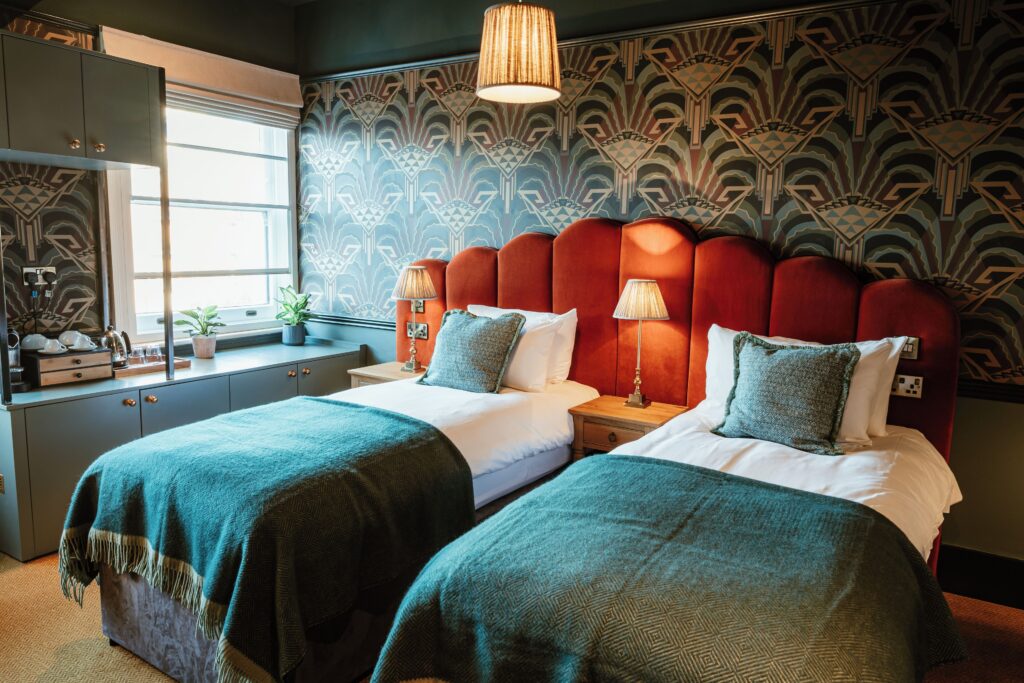
“West is best” is the local saying, and though everyone in Shoreditch and Hackney will disagree, Hammersmith and Fulham has its appeal.
Hammersmith in particular is just a 40 minute direct tube from Heathrow Airport and that same tube, the Piccadilly Line, can have you in Leicester Square, Piccadilly Circus or Covent Garden in 30 minutes, perfect for your sightseeing.
It also runs all night on Friday and Saturday which can save you a fortune in taxi costs if you’re enjoying London’s nightlife.
As a general rule, west London is greener and less densely packed than the rest of the city. Hammersmith and Fulham are both still busy areas but they feel far more like big towns than cities and the change of pace can be enjoyable, especially if you’re traveling with children or want to avoid the huge crowds of places like Covent Garden.
The Thames Path runs through the borough, an unbroken stretch that can be walked or cycled, filled with beautiful views, ducks, charming old pubs and even a couple of football stadiums – if you’re visiting London in the summer then a walk along a section of the Thames Path is one of the best things you can do.
I’ve lived along here for the past two years and its by far my favorite place to have lived – if you do fancy a pint then The Crabtree and The Blue Anchor are two riverside pubs I would recommend in the area.
Best Boutique Hotel Recommendations in and near Hammersmith & Fulham
- The Captain Cook Hotel (Fulham) – A charming boutique-style pub hotel offering cozy rooms, local character, and a relaxed neighborhood vibe. Great for those who want an authentic London experience away from the tourist crowds.
- Hand & Flower (Hammersmith) – A stylish pub-with-rooms pairing historic charm with modern comfort. Ideal for travelers who love the mix of a traditional London pub atmosphere and easy access to West London’s attractions.
- ibis London Shepherd’s Bush – Hammersmith (Shepherd’s Bush) – A reliable and affordable choice with clean, compact rooms and friendly service. Just steps from the Westfield shopping center and Underground links, it’s perfect for budget-conscious travelers.
- Dao by Dorsett West London (Shepherd’s Bush) – A modern aparthotel combining the flexibility of serviced apartments with the amenities of a hotel. Ideal for longer stays or travelers who prefer a home-away-from-home setup.
- St Paul’s Hotel (Hammersmith) – A historic boutique hotel set in a former school building, blending classic architecture with contemporary interiors. A refined yet relaxed option near Kensington and Hammersmith.
- The Hoxton, Shepherd’s Bush (Shepherd’s Bush) – Trendy and design-forward, The Hoxton offers stylish rooms, a lively bar, and the brand’s signature neighborhood feel. Perfect for travelers who want boutique comfort with a creative edge.
Top Things to do in Hammersmith & Fulham
Hammersmith’s Eventim Apollo is one of the most iconic venues in the UK, and is used for all manner of concerts and TV shows, including Britain’s Got Talent and the comedy show, Live at the Apollo.
Westfield shopping centre is reachable on foot in nearby White City and Fulham FC’s recently redeveloped Riverside stand is open to the public for food and drink on non-matchdays.
Where to Stay in London: South Bank & Waterloo
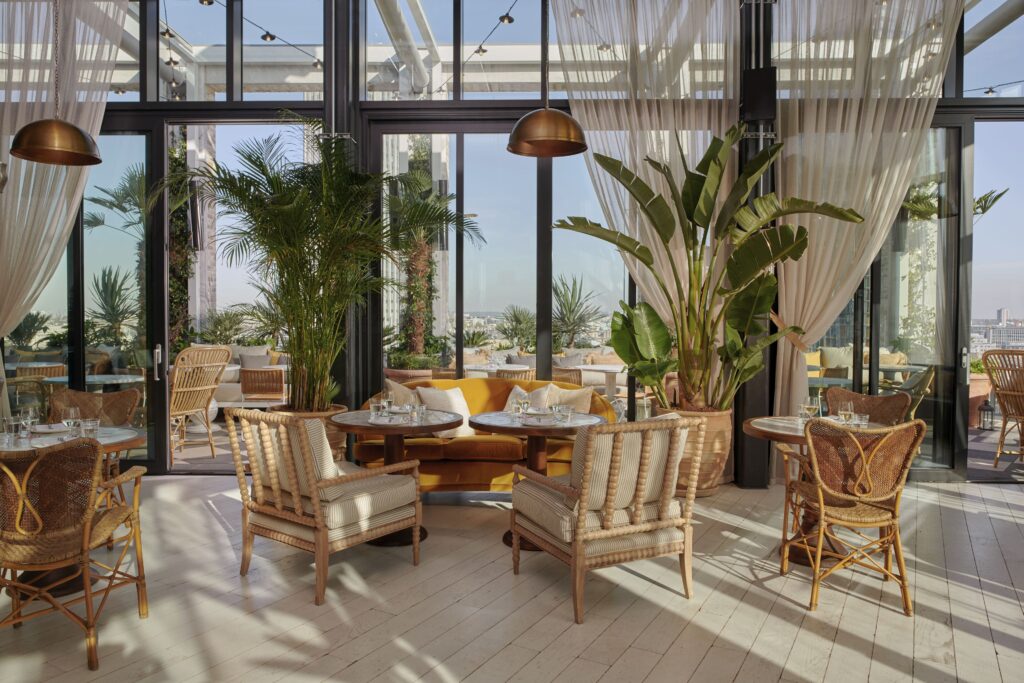
I actually think that for visitors, South Bank is a better base than Covent Garden. Yes, you are south of the river which makes some transportation more complex, but Waterloo is one of the largest train stations in the city, and you’re still well-connected through tube stations like Blackfriars and London Bridge.
There’s more stunning Thames-side walks (wide enough for buggies, wheelchairs and strollers) and places to eat and drink, plus you’re right on the doorstep of tourist attractions like the London Eye, the National Theatre, HMS Belfast and London Dungeon.
Westminster and the Houses of Parliament are also within easy reach by taxi or about 30 minutes on foot.
If Covent Garden is quieter by day and busier by night, then South Bank and Waterloo is the opposite. By evening, things generally quieten down here, meaning it can be a good option for families or if you prefer your peace and quiet after dark.
Accommodation will be more expensive the closer you get to the river, a rule that actually works for London more generally.
Best Boutique Hotel Recommendations in and near South Bank & Waterloo
- Marlin Waterloo (Waterloo) – A modern aparthotel offering spacious rooms with kitchenettes, ideal for longer stays or travelers who want extra flexibility. Conveniently located near Westminster and the South Bank for easy sightseeing.
- H10 London Waterloo (Waterloo) – A sleek, contemporary hotel with clean design, a rooftop bar, and panoramic city views. Perfect for travelers who want stylish comfort close to the River Thames and central attractions.
- The Dixon, Autograph Collection (Southwark) – Set in a beautifully restored Edwardian courthouse, The Dixon combines heritage charm with modern luxury. A great choice for design lovers who appreciate history and craftsmanship.
- The Hoxton, Southwark (Southwark) – Trendy and design-forward, The Hoxton offers warm, modern interiors, a lively restaurant scene, and unbeatable views from its rooftop bar. Perfect for travelers who love a creative, boutique vibe.
- The LaLiT London (Tower Bridge) – Housed in a former grammar school, The LaLiT blends British heritage with Indian hospitality. Expect elegant rooms, vibrant design, and a restaurant serving elevated Indian cuisine in a grand hall setting.
- Park Plaza London Westminster Bridge (South Bank) – A contemporary four-star hotel with sleek rooms, a spa, and an indoor pool, offering sweeping views of Big Ben and the Houses of Parliament. Ideal for first-time visitors who want modern comfort in the heart of the city.
- Sea Containers London (South Bank) – Stylish and sophisticated, Sea Containers brings a touch of riverside glamour with bold design, spacious rooms, and a rooftop bar overlooking the Thames. Perfect for travelers seeking a luxurious stay with personality.
Top Things to do in South Bank & Waterloo
As well as the big hitters I’ve already mentioned, the South Bank and Waterloo area is home to some interesting lesser-known attractions, including the authorized graffiti and street art of the Leake Street Arches and the BFI Southbank, which shows classic films and hosts a roster of speakers throughout the year.
Where to Stay in London: Kensington
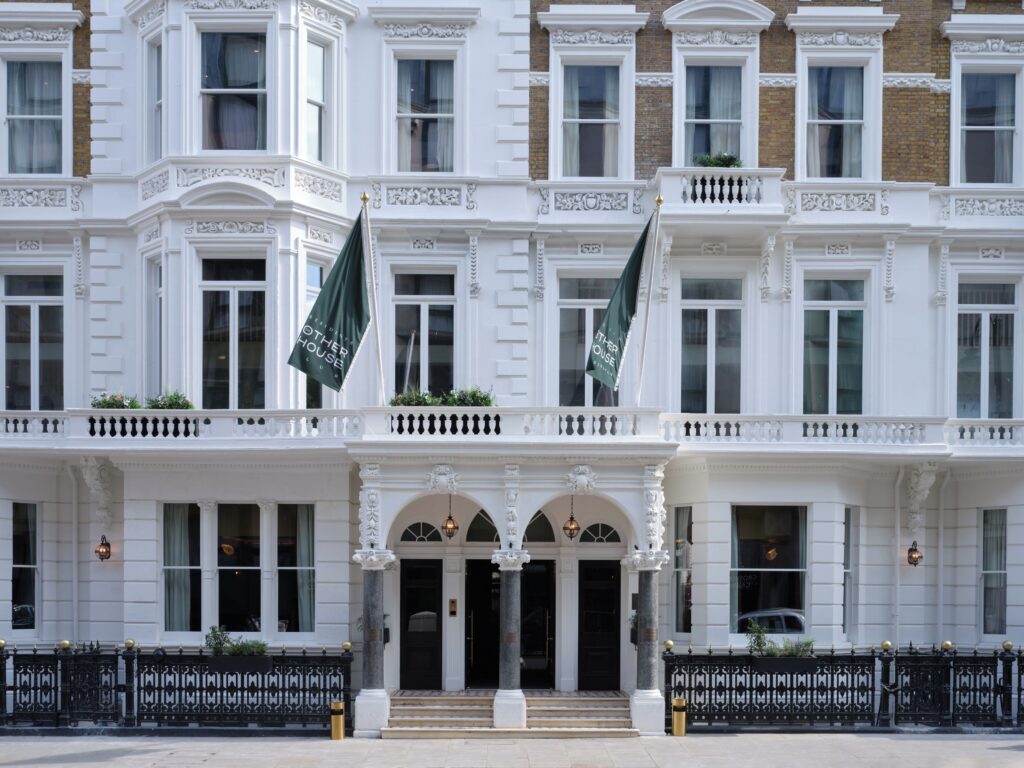
In some ways, Kensington is like Hammersmith & Fulham, though I’d argue it’s slightly more well-heeled and it’s not by the river (though it’s not far). It boasts great transport links to both Heathrow (via the Picadilly Line) and central London and is home to some of London’s most visited museums, namely the Natural History Museum and the Science Museum.
Kensington Gardens and Hyde Park are two of the largest green spaces in the city, which give this area a more relaxed and less busy feel, and make Kensington a great base for families to explore.
The downside of Kensington is the expense, not just of accommodation, but of just about everything. The Royal Borough of Kensington and Chelsea doesn’t exactly sound cheap, does it? Food, drink, shopping, you name it, it will cost more here.
If you’re completely set on staying in this area but want to lower your costs somewhat, then you can look for accommodation in the Earls Court or Gloucester Road area, which has a similar feel but without the price tag.
Best Boutique Hotel Recommendations in and near Kensington
- Mitre House Hotel (Paddington) – A classic, budget-friendly option that offers simple comfort and a welcoming atmosphere just steps from Hyde Park. A great pick for where to stay in London if you want convenience and value in a central location.
- Hotel Xenia, Autograph Collection (Kensington) – A stylish boutique hotel blending Victorian charm with modern elegance. With cozy rooms, a chic cocktail lounge, and easy access to museums, it’s a perfect choice for where to stay in London if you’re after affordable sophistication in West London.
- The Portobello Hotel (Notting Hill) – Bohemian and romantic, this boutique gem is known for its eclectic décor and rich history of celebrity guests. An unforgettable option for where to stay in London if you love individuality and the charm of Notting Hill.
- The Ampersand Hotel (South Kensington) – A design-forward boutique stay inspired by London’s museums and culture. Expect vibrant interiors, plush rooms, and a prime location near the Natural History Museum — one of the best picks for where to stay in London for art and design lovers
- The Other House South Kensington (South Kensington) – A stylish “residence club” offering apartment-style suites with hotel-level service. Perfect for travelers deciding where to stay in London for longer visits, privacy, and a modern British luxury vibe.
- Number Sixteen (South Kensington) – Chic and tranquil, Number Sixteen feels like a refined London townhouse with lush gardens, colorful interiors, and warm, personal service. A lovely choice for where to stay in London if you’re craving charm and calm in the city’s heart.
Top Things to do in Kensington
Kensington Palace was the birthplace of Queen Victoria and is the official London residence of The Prince and Princess of Wales. It’s open to the public, allowing visitors the chance to explore grand palaces, tuck into afternoon tea at the Orangery and wander around the manicured gardens.
Need more recs before you go? My 2-day London itinerary walks you through when to visit, what to see, and where to eat like a local.
Where to Stay in London With Family
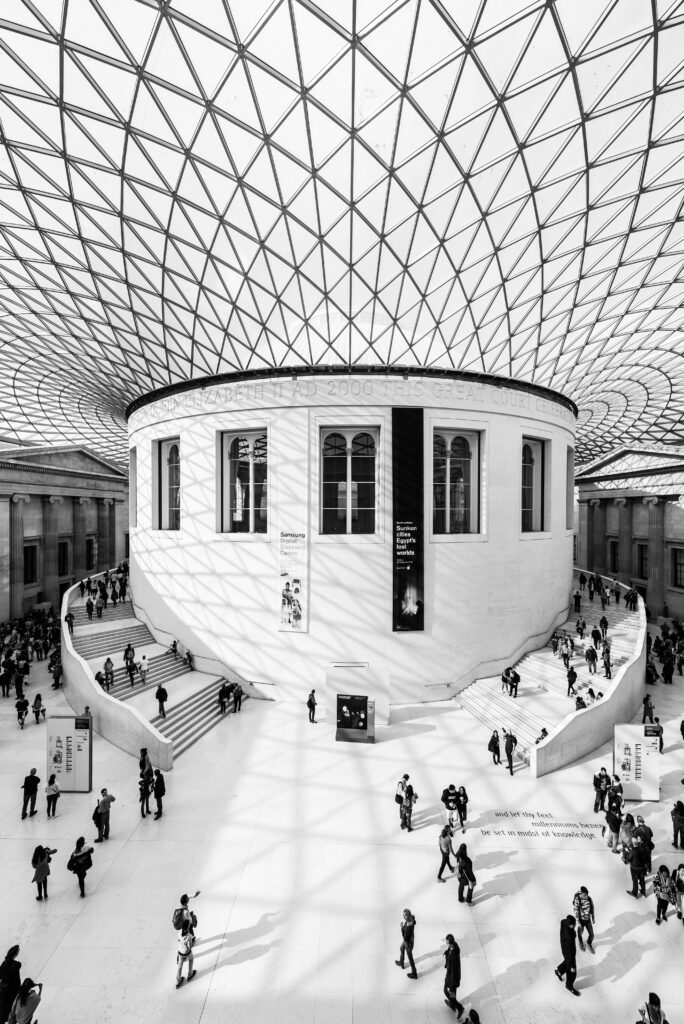
If you’re traveling with little ones and want to avoid the busiest crowds then of the areas in London I’ve mentioned, Kensington is probably the best option. It offers the closest proximity to some of the city’s main attractions, reducing your travel time, and offers a direct tube to Heathrow, which is always handy.
Kensington Gardens is also home to the Diana Memorial Playground. If you’re flying in early or late and want the shortest journey possible from Heathrow, then Hammersmith is a good option, whilst the quiet evenings of Waterloo make this a viable option too.
Places to avoid with children include Soho, Camden, Brixton, Shoreditch and Hackney – all great fun, but not recommended for kids.
Where Not to Stay in London
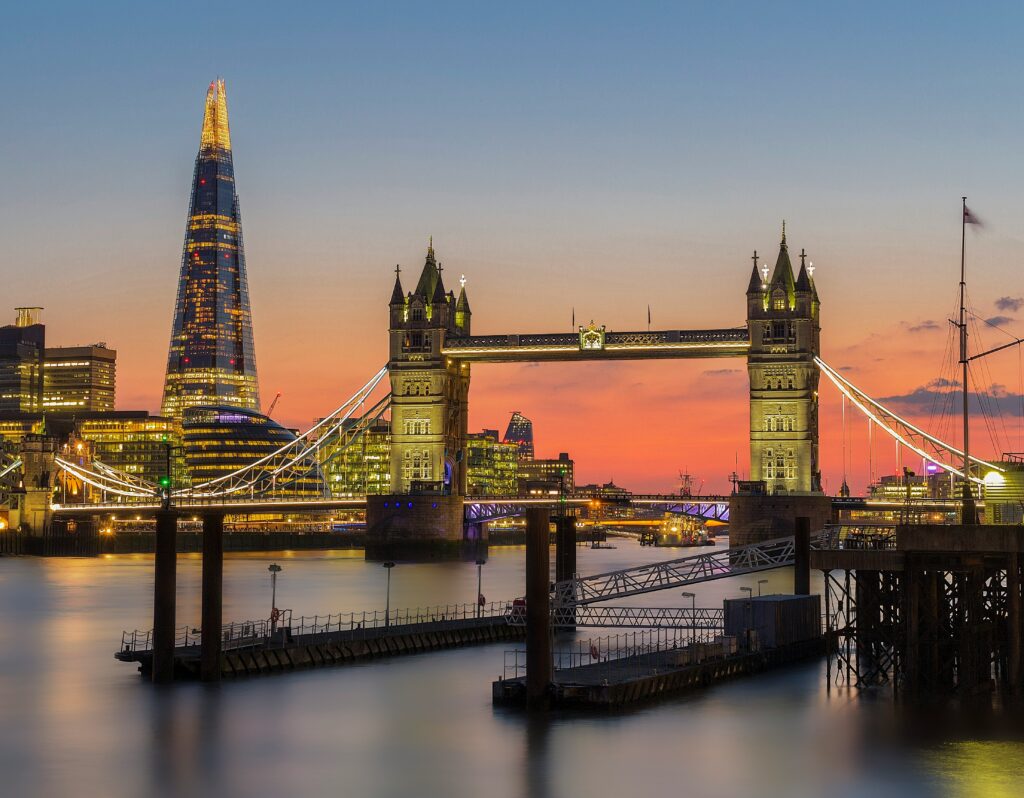
Realistically, the transport in London is so good that anywhere in zones 1 or 2 (inner London) is likely to be perfectly fine for a first time visit to the city, and one where you aim to tick off some of the main tourist sights.
London is huge, so although it might be tempting to book a hotel further out to save money and transfer time from the airport, I’d avoid far-our suburbs such as Croydon or Ilford if you’re coming to the city for tourism.
It’s important to note too that of London’s main airports, Luton, Stansted and Gatwick aren’t REALLY in London – so definitely don’t be staying around there when deciding where to stay in London!
And it goes without saying that like in all big cities, crime can strike anywhere in London. There aren’t necessarily places to avoid but it’s always good to keep your wits about you, especially at night.
Where to Stay in London: Final Thoughts
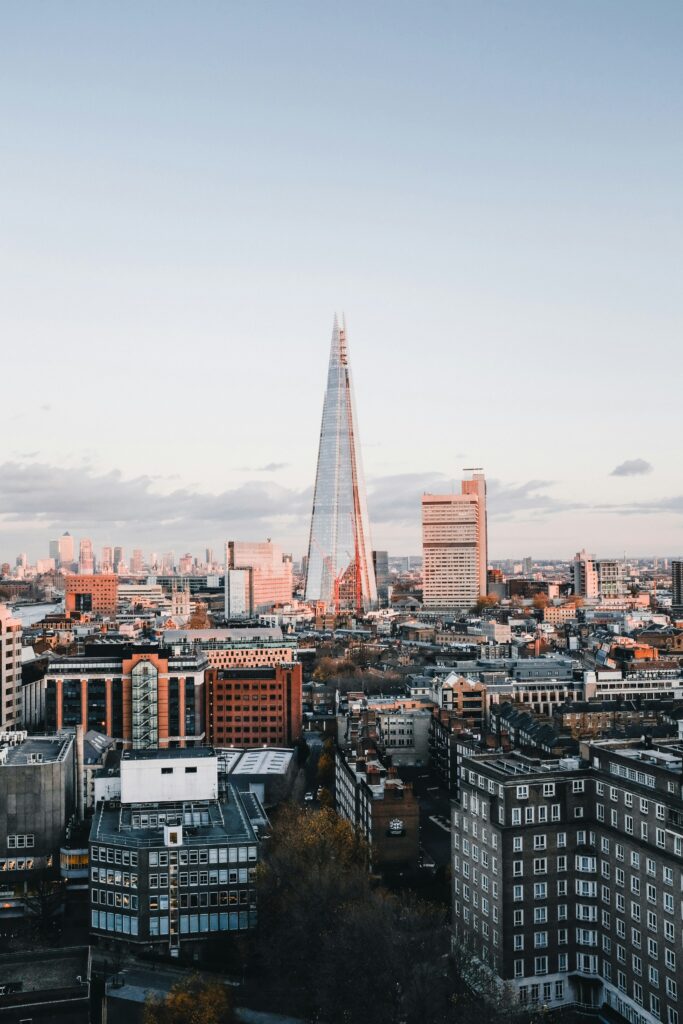
London is such a diverse city that deciding where to stay in London first time really can make a difference to the enjoyment of your trip. Some of its boroughs and areas feel like quintessential countryside towns, whilst in others the chaos and business can be both a blessing and a curse.
London’s main attractions aren’t all gathered in one place, so you will have to do some traveling around – seven years into living here I still use Citymapper for the majority of my journeys, and I’d recommend you download it and get to grips with the London Underground.
It’ll save you a fortune and is usually quicker than traveling by taxi anyway.
Wherever you stay in London, you’ll have a blast, and the ultimate decision should come down to your personal preferences, the reason for your trip and your budget.
Where did YOU end up staying for your first visit to London? Share your stories on where to stay in London in the comments below!
Visiting other parts of Europe?
Check out my other travel guides on Europe here.
Looking for travel inspiration to somewhere else?
October 26, 2025
Trying to figure out where to stay in London for your first visit to the Queen’s city? It can be a bit daunting am I right??? I’ve been there. Scrolling through endless TikToks and random lists of neighborhoods, trying to decode whether “central London” actually means central. (Spoiler: sometimes it doesn’t.)
So to save you the headache, I teamed up with my friend Ben Bromley, a true London local to help you narrow it down. In this guide, we’re breaking down the best places to stay in London for first-time visitors, from classic landmarks in central London to the coolest areas in London you won’t want to miss. Whether you’re searching for where to stay in London first time or just want the inside scoop on the prettiest corners of the city, our list has you covered.
All the content below was written by Ben, but every design-forward boutique hotel was handpicked by me — so you’re getting the best of both worlds: a true London expert guiding you on where to stay in London for your first visit, plus my travel blogger eye for stylish (yet clean and comfortable) stays.
So take that last sip of your afternoon high tea and let’s get into it 👇

Read more on London 🇬🇧
This site contains affiliate links, which means I may earn a small commission if you make a purchase through them (which will likely go towards overpriced airport wine or buying my dog more unnecessary toys). However, none of that impacts the integrity of my reviews. All thoughts and opinions are my own.
Best Hotels in London at a Glance

Short on time? Here are my top picks for the best boutique hotels in London for first-time visitors:
- The Hoxton, Holborn (Holborn) – Stylish and effortlessly hip, The Hoxton pairs industrial-chic interiors with a lively social energy — a top pick when deciding where to stay in London near Covent Garden and the British Museum.
- citizenM London Shoreditch (Shoreditch) – Modern, playful, and ultra-smart, citizenM blends sleek design with self-check-in ease — a top pick for where to stay in London if you love creative, personality-filled hotels.
- Hand & Flower (Hammersmith) – A cozy pub-with-rooms that balances old-world charm with updated comfort. Ideal for visitors craving the warmth of a classic London pub vibe and quick access to West London highlights.
- The Dixon, Autograph Collection (Southwark) – Housed in a restored Edwardian courthouse, The Dixon blends heritage architecture with modern luxury — a standout pick for where to stay in London if you love design and history.
- The Ampersand Hotel (South Kensington) – A boutique gem inspired by London’s rich cultural scene, featuring bold interiors and plush, artful rooms. Set just steps from the Natural History Museum and Kensington Gardens, it’s perfect for style-savvy explorers.
Figuring out Where to Stay in London: Overview
Ok so it might not boast the best weather, a pint costs nearly £8 and the people can be a bit rude (I’m saying this as a local), but London (and yes, I’m biased) is one of the greatest cities in the world. You’re never going to run out of things to do, the transport connections are excellent and the city has some of the best culture, history, shopping and dining of anywhere.
Whether you want to ride to the top of the Shard or step back into history at the Tower of London. Whether you want to channel your inner royalty at Buckingham Palace or ride the London Eye.
And whether you want to walk for miles along the unbroken Thames Path or hit up the old school East End, it’s all possible in London.
But by far my favorite thing about living in London is the sheer diversity of boroughs and neighborhoods. How you can go from the multi-million pound mansions of Kensington to the terraces of East London, massive green spaces like Hyde Park to beautiful river walks in Richmond and densely packed urban areas like Camden, with all the buzz it brings.
And diverse communities of all nationalities, creeds and religions mingling with tourists, whether at the Notting Hill Carnival or Soho’s London Pride.
London is a truly welcoming city, and if you’re planning a visit then I’ve got some great recommendations for where you can stay.
Snapshot of London Boroughs & Neighborhoods

There are 32 London boroughs plus the City of London and most of these can be broken down further. You have better things to be doing than reading my thoughts on all 32, so I’ve taken five of my favorites to drill into: Covent Garden, Shoreditch, Hammersmith & Fulham, South Bank & Waterloo and Kensington. But before I get into those, there’s loads of other options for you to consider. Here’s a (very) brief summary:
Soho: Compact, lively, and packed with nightlife. London’s LGBTQ+ heart and perfect if you thrive on late evenings, cocktail bars, and tiny streets full of energy. The downside: it should be pedestrianized.
Mayfair: The most expensive property on the Monopoly board. Refined and exclusive, home to luxury hotels, Michelin-star dining, and high-end shopping. Not for you if you’re on a budget, but if you enjoy the finer things, it’s the neighborhood for you.
Notting Hill: I’m not even joking, I actually saw Hugh Grant drive his Lamborghini through Notting Hill once. Famous for its colorful houses and Portobello Road Market, plus the annual Notting Hill Carnival. Great for those who like bookshops, weekend markets, and a charming, village-like atmosphere.
Camden: Alternative, music-driven, and a little gritty. Best for younger travellers or anyone into live music, street food, and countercultural energy. You will pay £8 for a craft beer and it probably won’t taste very nice.
Greenwich: Massive redevelopment going on here, it’s still emerging but the appeal is there. A good option for families or history lovers wanting to check out the Cutty Sark.
Chelsea: Another of West London’s rich districts. Stylish and residential, with more Ferraris than Fiats. But also football-mad (I’m not calling it soccer, this is a guest post) and full of great pubs.
Richmond: Perfect for river walks and home to one of London’s largest royal parks, with deer sightings guaranteed. Ideal if you want calm, long walks, and a brush with well-heeled locals – celebrities from Mick Jagger to David Attenborough and Tom Hardy to Keira Knightley call Richmond home.
Bloomsbury: A quiet, walkable central base, with easy access to the British Museum and garden squares. Not too much going on after dark but well connected to the rest of the city.
Canary Wharf: London’s modern financial centre with towering skyscrapers and (uber expensive) riverside apartments. One of the top areas in London for business travelers or those who prefer modern hotels and easy Docklands connections.
Southwark: A perfect central location south of London Bridge, known for Borough Market, Southwark Cathedral, and The Shard. Ideal for foodies and anyone wanting a lively yet less tourist-heavy area close to central attractions.
Where to Stay in London: Covent Garden

If money is no object and you’re trying to decide where to stay in central London, then Covent Garden is about as good as it gets.
The name comes from the fact that it used to be the garden of nearby Westminster Abbey and today it’s walkable, buzzes with activity at night and is close to many of the city’s top tourist attractions, including the West End, Trafalgar Square and cultural highlights including the National Gallery.
Transport links are excellent, in fact you’ll find it’s often easier to walk to Covent Garden from either Leicester Square or Holborn, as the Covent Garden tube station can be absolutely packed on a weekend evening – top local tip for you there.
There’s load of al fresco dining and drinking and you tend to find a street performer or two in the area. Just be wary, as pickpockets and phone thieves target the busy crowds, so take precautions when exploring.
And the biggest downside of Covent Garden is the cost of everything, especially accommodation and drinks.
Best Boutique Hotel Recommendations in and near Covent Garden
- The Z Hotel Piccadilly (West End) – A compact yet stylish budget-friendly option right in the middle of the action. With smart rooms, modern design, and a prime location between Soho and Leicester Square, it’s perfect for travelers who want to stay central without splurging.
- Club Quarters Hotel, Covent Garden Holborn (Covent Garden) – A practical and comfortable stay in one of London’s liveliest areas, this hotel is ideal for business and leisure travelers alike. If you’re deciding where to stay in London for easy access to West End theaters, restaurants, and attractions, this spot checks every box.
- The Hoxton, Holborn (Holborn) – Trendy and effortlessly cool, The Hoxton blends industrial-chic interiors with a buzzy social vibe. Perfect for design lovers who want a stylish base near Covent Garden and the British Museum.
- Page8, Page Hotels (Trafalgar Square) – A sleek boutique hotel offering a modern, minimalist retreat just steps from Trafalgar Square. With its bright rooms, calm aesthetic, and rooftop café, it’s a great pick for where to stay in London if you want a stylish base in the heart of the city.
- NoMad London (Covent Garden) – Set in a restored courthouse, NoMad brings New York sophistication to London. Expect luxurious interiors, a stunning glass-ceilinged restaurant, and the perfect mix of historic charm and modern elegance.
- One Aldwych (Covent Garden) – Contemporary and refined, this five-star hotel pairs elegant rooms with thoughtful touches like an indoor pool and an afternoon tea inspired by Charlie and the Chocolate Factory. A standout option for where to stay in London if you’re after quiet luxury in the West End.
- The Londoner (Leicester Square) – A five-star urban resort that’s both glamorous and intimate, offering sleek rooms, multiple bars and restaurants, and a serene underground spa. Perfect for travelers deciding where to stay in London for the ultimate luxury experience with everything at their doorstep.
Top Things to do in Covent Garden
Aside from eating, drinking and shopping, you can catch a show at one of the numerous West End theatres, jump into the history of the London Underground at the Transport Museum or take a short stroll along the river to Somerset House, home to a rotating array of art exhibitions throughout the year.
Looking for more things to do? My 2-day London itinerary is packed with can’t-miss attractions and foodie finds.
Where to Stay in London: Shoreditch

Shoreditch is an area to the east of central London, north of the City of London financial district. It’s a bit more edgy and creative, with fewer obvious tourist attractions but loads of options for nights out and dining – it’s a really popular place to live for people moving to London from elsewhere in the UK or arriving to work from Australia, the US and elsewhere.
Transport links to the city center are good, though it’s a bit more of a pain to get west (to Heathrow, for example).
In many ways, Shoreditch represents “new” London, and is a great example of an area that has evolved with the times – think industrial buildings converted into event spaces and nightclubs (Village Underground is one of my favorite nights out in London), bougee restaurants and lots of indie coffee spots.
The Tower of London and St Paul’s are two landmarks within easy reach and your accommodation costs will be lower here than in the centre, but by no means cheap.
If you’re a young person moving to London either for the short or long term then Shoreditch is one of the best places to stay in London, if you’re heading on vacation then it can work too, but you might prefer somewhere with better transport links.
Best Boutique Hotel Recommendations in and near Shoreditch
- Point A Hotel London Shoreditch (Shoreditch) – A simple yet stylish budget hotel with compact rooms and modern touches, ideal for travelers who value location and comfort without breaking the bank. Perfect for exploring East London’s creative scene on foot.
- The Z Hotel Shoreditch (Shoreditch) – A smart, budget-friendly stay offering contemporary design and excellent value. With compact rooms and a location right by Old Street Station, it’s great for first-time visitors who want convenience and affordability in one.
- citizenM London Shoreditch (Shoreditch) – Playful, modern, and tech-savvy, citizenM blends smart design with self-check-in convenience and colorful communal spaces. Perfect for solo travelers or couples who love a stylish stay with personality.
- The Hoxton, Shoreditch (Shoreditch) – Trendy and effortlessly cool, The Hoxton captures the neighborhood’s creative spirit with vintage-inspired interiors and a lively lobby scene. A great pick for design lovers and social travelers.
- One Hundred Shoreditch (Shoreditch) – A sleek, contemporary hotel offering airy rooms, warm tones, and one of the best rooftop bars in East London. Ideal for travelers who want a polished, modern base in the heart of Shoreditch.
- Virgin Hotels London Shoreditch (Shoreditch) – Vibrant and full of personality, Virgin Hotels brings a playful energy to Shoreditch with chic rooms, bold design, and a buzzing social atmosphere. Great for those who like a stylish stay with a side of fun.
- art’otel London Hoxton (Hoxton) – A design-led hotel that doubles as an art gallery, featuring works by contemporary artists and sleek, minimalist rooms. Perfect for travelers who appreciate creativity, culture, and a luxury boutique vibe.
- Pan Pacific London (Liverpool Street) – Refined and serene, Pan Pacific blends modern luxury with Asian-inspired hospitality. With spacious rooms, an elegant spa, and a pool overlooking the skyline, it’s one of Shoreditch’s most sophisticated stays.
Top Things to do in Shoreditch
A bring your own booze curry on Brick Lane is a London staple, and you can also browse for everything from antiques to street food at the Old Spitalfields Market. If electronic music is your thing then Village Underground is a great night out – bring your ear protection because the sound system is something else.
Can’t get enough of London? My 2-day London itinerary has everything you need — from top attractions to hidden gems and the best food stops.
Where to Stay in London: Hammersmith & Fulham

“West is best” is the local saying, and though everyone in Shoreditch and Hackney will disagree, Hammersmith and Fulham has its appeal.
Hammersmith in particular is just a 40 minute direct tube from Heathrow Airport and that same tube, the Piccadilly Line, can have you in Leicester Square, Piccadilly Circus or Covent Garden in 30 minutes, perfect for your sightseeing.
It also runs all night on Friday and Saturday which can save you a fortune in taxi costs if you’re enjoying London’s nightlife.
As a general rule, west London is greener and less densely packed than the rest of the city. Hammersmith and Fulham are both still busy areas but they feel far more like big towns than cities and the change of pace can be enjoyable, especially if you’re traveling with children or want to avoid the huge crowds of places like Covent Garden.
The Thames Path runs through the borough, an unbroken stretch that can be walked or cycled, filled with beautiful views, ducks, charming old pubs and even a couple of football stadiums – if you’re visiting London in the summer then a walk along a section of the Thames Path is one of the best things you can do.
I’ve lived along here for the past two years and its by far my favorite place to have lived – if you do fancy a pint then The Crabtree and The Blue Anchor are two riverside pubs I would recommend in the area.
Best Boutique Hotel Recommendations in and near Hammersmith & Fulham
- The Captain Cook Hotel (Fulham) – A charming boutique-style pub hotel offering cozy rooms, local character, and a relaxed neighborhood vibe. Great for those who want an authentic London experience away from the tourist crowds.
- Hand & Flower (Hammersmith) – A stylish pub-with-rooms pairing historic charm with modern comfort. Ideal for travelers who love the mix of a traditional London pub atmosphere and easy access to West London’s attractions.
- ibis London Shepherd’s Bush – Hammersmith (Shepherd’s Bush) – A reliable and affordable choice with clean, compact rooms and friendly service. Just steps from the Westfield shopping center and Underground links, it’s perfect for budget-conscious travelers.
- Dao by Dorsett West London (Shepherd’s Bush) – A modern aparthotel combining the flexibility of serviced apartments with the amenities of a hotel. Ideal for longer stays or travelers who prefer a home-away-from-home setup.
- St Paul’s Hotel (Hammersmith) – A historic boutique hotel set in a former school building, blending classic architecture with contemporary interiors. A refined yet relaxed option near Kensington and Hammersmith.
- The Hoxton, Shepherd’s Bush (Shepherd’s Bush) – Trendy and design-forward, The Hoxton offers stylish rooms, a lively bar, and the brand’s signature neighborhood feel. Perfect for travelers who want boutique comfort with a creative edge.
Top Things to do in Hammersmith & Fulham
Hammersmith’s Eventim Apollo is one of the most iconic venues in the UK, and is used for all manner of concerts and TV shows, including Britain’s Got Talent and the comedy show, Live at the Apollo.
Westfield shopping centre is reachable on foot in nearby White City and Fulham FC’s recently redeveloped Riverside stand is open to the public for food and drink on non-matchdays.
Where to Stay in London: South Bank & Waterloo

I actually think that for visitors, South Bank is a better base than Covent Garden. Yes, you are south of the river which makes some transportation more complex, but Waterloo is one of the largest train stations in the city, and you’re still well-connected through tube stations like Blackfriars and London Bridge.
There’s more stunning Thames-side walks (wide enough for buggies, wheelchairs and strollers) and places to eat and drink, plus you’re right on the doorstep of tourist attractions like the London Eye, the National Theatre, HMS Belfast and London Dungeon.
Westminster and the Houses of Parliament are also within easy reach by taxi or about 30 minutes on foot.
If Covent Garden is quieter by day and busier by night, then South Bank and Waterloo is the opposite. By evening, things generally quieten down here, meaning it can be a good option for families or if you prefer your peace and quiet after dark.
Accommodation will be more expensive the closer you get to the river, a rule that actually works for London more generally.
Best Boutique Hotel Recommendations in and near South Bank & Waterloo
- Marlin Waterloo (Waterloo) – A modern aparthotel offering spacious rooms with kitchenettes, ideal for longer stays or travelers who want extra flexibility. Conveniently located near Westminster and the South Bank for easy sightseeing.
- H10 London Waterloo (Waterloo) – A sleek, contemporary hotel with clean design, a rooftop bar, and panoramic city views. Perfect for travelers who want stylish comfort close to the River Thames and central attractions.
- The Dixon, Autograph Collection (Southwark) – Set in a beautifully restored Edwardian courthouse, The Dixon combines heritage charm with modern luxury. A great choice for design lovers who appreciate history and craftsmanship.
- The Hoxton, Southwark (Southwark) – Trendy and design-forward, The Hoxton offers warm, modern interiors, a lively restaurant scene, and unbeatable views from its rooftop bar. Perfect for travelers who love a creative, boutique vibe.
- The LaLiT London (Tower Bridge) – Housed in a former grammar school, The LaLiT blends British heritage with Indian hospitality. Expect elegant rooms, vibrant design, and a restaurant serving elevated Indian cuisine in a grand hall setting.
- Park Plaza London Westminster Bridge (South Bank) – A contemporary four-star hotel with sleek rooms, a spa, and an indoor pool, offering sweeping views of Big Ben and the Houses of Parliament. Ideal for first-time visitors who want modern comfort in the heart of the city.
- Sea Containers London (South Bank) – Stylish and sophisticated, Sea Containers brings a touch of riverside glamour with bold design, spacious rooms, and a rooftop bar overlooking the Thames. Perfect for travelers seeking a luxurious stay with personality.
Top Things to do in South Bank & Waterloo
As well as the big hitters I’ve already mentioned, the South Bank and Waterloo area is home to some interesting lesser-known attractions, including the authorized graffiti and street art of the Leake Street Arches and the BFI Southbank, which shows classic films and hosts a roster of speakers throughout the year.
Where to Stay in London: Kensington

In some ways, Kensington is like Hammersmith & Fulham, though I’d argue it’s slightly more well-heeled and it’s not by the river (though it’s not far). It boasts great transport links to both Heathrow (via the Picadilly Line) and central London and is home to some of London’s most visited museums, namely the Natural History Museum and the Science Museum.
Kensington Gardens and Hyde Park are two of the largest green spaces in the city, which give this area a more relaxed and less busy feel, and make Kensington a great base for families to explore.
The downside of Kensington is the expense, not just of accommodation, but of just about everything. The Royal Borough of Kensington and Chelsea doesn’t exactly sound cheap, does it? Food, drink, shopping, you name it, it will cost more here.
If you’re completely set on staying in this area but want to lower your costs somewhat, then you can look for accommodation in the Earls Court or Gloucester Road area, which has a similar feel but without the price tag.
Best Boutique Hotel Recommendations in and near Kensington
- Mitre House Hotel (Paddington) – A classic, budget-friendly option that offers simple comfort and a welcoming atmosphere just steps from Hyde Park. A great pick for where to stay in London if you want convenience and value in a central location.
- Hotel Xenia, Autograph Collection (Kensington) – A stylish boutique hotel blending Victorian charm with modern elegance. With cozy rooms, a chic cocktail lounge, and easy access to museums, it’s a perfect choice for where to stay in London if you’re after affordable sophistication in West London.
- The Portobello Hotel (Notting Hill) – Bohemian and romantic, this boutique gem is known for its eclectic décor and rich history of celebrity guests. An unforgettable option for where to stay in London if you love individuality and the charm of Notting Hill.
- The Ampersand Hotel (South Kensington) – A design-forward boutique stay inspired by London’s museums and culture. Expect vibrant interiors, plush rooms, and a prime location near the Natural History Museum — one of the best picks for where to stay in London for art and design lovers
- The Other House South Kensington (South Kensington) – A stylish “residence club” offering apartment-style suites with hotel-level service. Perfect for travelers deciding where to stay in London for longer visits, privacy, and a modern British luxury vibe.
- Number Sixteen (South Kensington) – Chic and tranquil, Number Sixteen feels like a refined London townhouse with lush gardens, colorful interiors, and warm, personal service. A lovely choice for where to stay in London if you’re craving charm and calm in the city’s heart.
Top Things to do in Kensington
Kensington Palace was the birthplace of Queen Victoria and is the official London residence of The Prince and Princess of Wales. It’s open to the public, allowing visitors the chance to explore grand palaces, tuck into afternoon tea at the Orangery and wander around the manicured gardens.
Need more recs before you go? My 2-day London itinerary walks you through when to visit, what to see, and where to eat like a local.
Where to Stay in London With Family

If you’re traveling with little ones and want to avoid the busiest crowds then of the areas in London I’ve mentioned, Kensington is probably the best option. It offers the closest proximity to some of the city’s main attractions, reducing your travel time, and offers a direct tube to Heathrow, which is always handy.
Kensington Gardens is also home to the Diana Memorial Playground. If you’re flying in early or late and want the shortest journey possible from Heathrow, then Hammersmith is a good option, whilst the quiet evenings of Waterloo make this a viable option too.
Places to avoid with children include Soho, Camden, Brixton, Shoreditch and Hackney – all great fun, but not recommended for kids.
Where Not to Stay in London

Realistically, the transport in London is so good that anywhere in zones 1 or 2 (inner London) is likely to be perfectly fine for a first time visit to the city, and one where you aim to tick off some of the main tourist sights.
London is huge, so although it might be tempting to book a hotel further out to save money and transfer time from the airport, I’d avoid far-our suburbs such as Croydon or Ilford if you’re coming to the city for tourism.
It’s important to note too that of London’s main airports, Luton, Stansted and Gatwick aren’t REALLY in London – so definitely don’t be staying around there when deciding where to stay in London!
And it goes without saying that like in all big cities, crime can strike anywhere in London. There aren’t necessarily places to avoid but it’s always good to keep your wits about you, especially at night.
Where to Stay in London: Final Thoughts

London is such a diverse city that deciding where to stay in London first time really can make a difference to the enjoyment of your trip. Some of its boroughs and areas feel like quintessential countryside towns, whilst in others the chaos and business can be both a blessing and a curse.
London’s main attractions aren’t all gathered in one place, so you will have to do some traveling around – seven years into living here I still use Citymapper for the majority of my journeys, and I’d recommend you download it and get to grips with the London Underground.
It’ll save you a fortune and is usually quicker than traveling by taxi anyway.
Wherever you stay in London, you’ll have a blast, and the ultimate decision should come down to your personal preferences, the reason for your trip and your budget.
Where did YOU end up staying for your first visit to London? Share your stories on where to stay in London in the comments below!
Visiting other parts of Europe?
Check out my other travel guides on Europe here.
PLEASE COMMENT BELOW